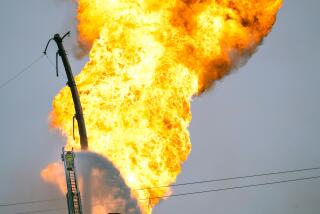Twice-Ruptured Mobil Pipeline Passes Test for Weak Spots
An underground pipeline through the San Fernando Valley that ruptured twice this month has passed high-pressure testing for weak spots, Mobil Oil Co. said Thursday.
About 500 gallons of oil and from 50,000 to 60,000 gallons of water leaked into a Sherman Oaks neighborhood and into the Los Angeles River when the Mobil pipeline ruptured Tuesday during such hydrostatic testing, officials said.
The line ruptured for the first time Sept. 10, when 90,000 gallons of crude oil spilled into an Encino neighborhood. About 8,000 gallons of that oil made its way into the river, officials said.
Mobil and state officials said there is little danger that the line will rupture again.
“I wouldn’t worry about it once it has been tested,” said Robert Gorham, associate pipeline safety engineer with the state fire marshal’s office.
“We all feel pretty comfortable with it,” said Tim Salles, operations manager for Mobil. “Everything in the Valley has been tested. You have a very good margin of safety following these tests.”
More than 20 miles of the pipeline, which runs from Bakersfield to the Mobil refinery in Torrance, has been tested in the Valley this week. Water was pumped through several segments of the line at 25% greater than maximum operating pressure after residual oil was pumped out.
The testing, in which the line must withstand the high pressure for four hours, is designed to locate weak spots or leaks, officials said.
“If there are weak spots, you want them to show up during the test when you have water in the pipe and not product,” Salles said.
Indeed, while the testing was under way Tuesday, the pipeline ruptured beneath the 4400 block of Sherman Oaks Avenue, spilling the 500 gallons of oil and 50,000 to 60,000 gallons of water, the Los Angeles Fire Department said. But Mobil officials said the pipe segment contained 126,000 gallons of water and that most of it leaked through the rupture.
A 14-foot section of ruptured pipe was replaced, and that segment of the line was retested Wednesday night with no resulting problems, Salles said.
Workers continued Thursday to steam clean the area of Sherman Oaks Avenue and Sherman Oaks Circle where thick oil congealed after the rupture Tuesday. The area remained closed to through traffic.
The hydrostatic testing of the pipeline is required every five years by the state fire marshal’s office. Mobil tests the line every two years in the Los Angeles area as an added safety precaution, Salles said.
Although the fire marshal’s office has not concluded its investigation of the Sept. 10 rupture, Mobil officials said it was caused by exterior corrosion of the 12-inch-in-diameter line.
More to Read
Sign up for Essential California
The most important California stories and recommendations in your inbox every morning.
You may occasionally receive promotional content from the Los Angeles Times.








